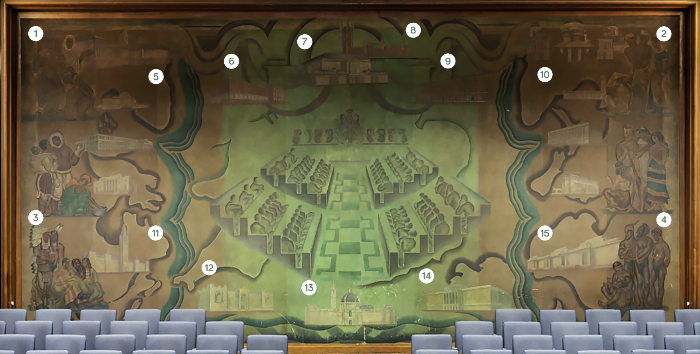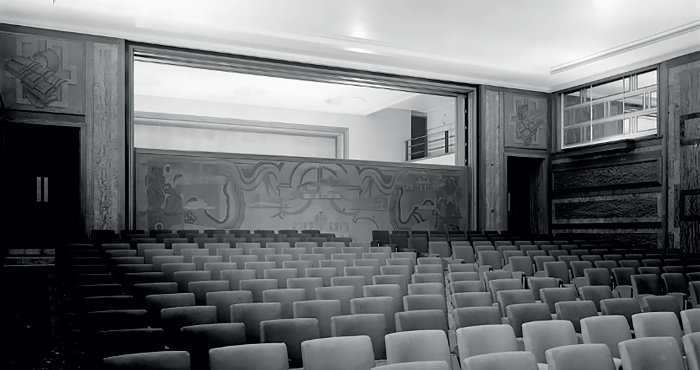The Jarvis Mural
This painted mural can be found in the Henry Jarvis Memorial Hall of the RIBA’s headquarters building at 66 Portland Place. The ‘disappearing’ screen was designed to separate the lecture theatre from its foyer. For busy events, the screen could be lowered to create an overspill space.
The mural was painted by the artist Edward Bainbridge Copnall, who also produced a number of sculptural works for the building. He was assisted by Nicholas Harris. They transferred the designs onto the canvas using templates, before painting the detail directly onto the mural.
The subject matter for the mural was likely a collaboration between Copnall and the building’s architect, George Grey Wornum.
At the centre of the image sits a representation of the RIBA Council, surrounded by buildings connected with British imperial rule. This symbolism presents the RIBA as an imperial parliament of architects at the centre of the world, linked with architectural societies and institutions throughout the British Empire.
At the edges are groups of Indigenous people of South Africa, India, Canada, and Australia. Their placement away from the buildings reflects the way they were excluded and marginalised from these seats of government under British rule.

People
The portrayal of the Indigenous figures is troubling in the way it embodies offensive racial stereotypes. The people are shown as outsiders, in huddled poses suggesting timidity and compliance. They are presented as primitive ‘natives’, with objectified bodies and exaggerated muscles, in contrast to the sophisticated and spatially ordered RIBA Council, represented as a homogenous tier of faceless men.
We can see:
1. A group of South African figures. The men are shown with dropped wrists and bent knees as if dancing, the women are seated.
2. A group of Indian men in turbans and a woman in a saree. Seated next to them is a woman in a conical hat.
3. A group of Canadian Inuit and First Nations figures, the men with elaborate feather headpieces
4. A group of Aboriginal Australians, with a seated female figure breastfeeding a baby
Buildings
The ring surrounding the RIBA Council represents the parliamentary, governmental, and colonial administrative buildings of the British Empire. Many were designed by RIBA Members, such as Herbert Baker, Edwin Lutyens, and John Smith Murdoch.
5. Union Buildings, Pretoria
6. 19-23 Abercromby Square, Liverpool University
7. Bank of England, London
8. Palace of Westminster, London
9. The Architectural Association, London
10. The Viceroy’s Palace (now Rashtrapati Bhavan), and Secretariat Buildings, New Delhi
11. Canadian Parliament Buildings, Ottawa
12. Scottish National War Memorial, Edinburgh
13. Cardiff City Hall
14. Parliament Buildings, Stormont
15. Provisional Parliament House (now Old Parliament House), Canberra
Find out more about symbols of the British Empire in RIBA's building and collections.
This interpretation is based on research by Dr Neal Shasore.
The Jarvis Mural sits alongside other features in our building, and materials and descriptions within our collections, that are outdated and offensive or need further contextualising. We continue to work to address this to ensure our building, collections and descriptions are appropriate for audiences today.








